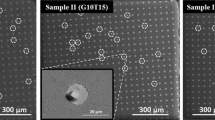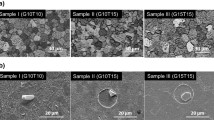Abstract
This paper presents experimental results supporting a theory that electric fields accelerate the growth of tin (Sn) whiskers. We have rapidly (within one week) grown long (≈100 urn) and dense (≈300 mrrr2) whiskers on thin Sn films. Humidity and an applied electric field are found to have a strong effect when applied together, making whiskers orders of magnitude longer and denser. An evidence of explosive whisker development is presented.








Similar content being viewed by others
References
G.T. Galyon: Annotated tin whisker bibliography and anthology. IEEE Trans. Electron. Packag. Manuf. 28, 94 (2005). http://thor.inemi.org/webdownload/newsroom/TW_,biblio-July03.pdf
J. Brusse, G. Ewell, and J. Siplon: In Tin Whiskers: Attributes and Mitigation, Capacitor and Resistor Technology Symp. (CARTS), (New Orleans, LA) March 25-29, (2002), pp. 68–80.
G. Davy: Private communication, October 2014; quoted in V.G. Karpov: Electrostatic mechanism of nucleation and growth of metal whiskers. SMT Magazine, February 2015, p. 28. http://iconnect007.uberflip.com/i/455818/44
Y. Zhang: Tin whisker discovery and research. In Soldering in Electronics, edited by K. Suganuma (Marcel Dekker, Inc., New York, 2004), p. 121.
K.N. Tu, J.O. Suh, and A.T. Wu: Tin whisker growth on lead-free solder finishes. In Lead-Free Solder Interconnect Reliability, edited by D. Shangguan (ASM International, Materials Park, Ohio, 2005), p. 851.
D. Bunyan, M.A. Ashworth, G.D. Wilcox, R.L. Higginson, R.J. Heath, and C. Liu: Tin whisker growth from electroplated finishes a review. Trans. Inst. Met. Finish. 91, 249–259 (2013).
NASA Goddard Space Flight Center Tin Whisker Homepage. http://nepp.nasa.gov/whisker. Bibliography for Tin Whiskers, Zinc Whiskers, Cadmium Whiskers, Indium Whiskers, and Other Conductive Metal and Semiconductor Whiskers, John R. Barnes, http://www.dbicorporation.com/whiskbib.htm
I. Amato: Tin whiskers: the next Y2K problem? Fortune Mag. 151, 27 (2005). http://archive.fortune.com/magazines/fortune/fortune_archive/2005/01/10/8230971/index.htm
V.G. Karpov: Electrostatic theory of metal whiskers. Phys. Rev. Appl. 1, 044001 (2014).
V.G. Karpov: Electrostatic mechanism of nucleation and growth of metal whiskers. SMT Magazine, February 2015, p. 28. http://iconnect007.uber-flip.com/i/455818/44
S.H. Liu, C. Chen, P.C. Liu, and T. Chou: Tin whisker growth driven by electrical currents. J. Appl. Phys. 95, 7742 (2004).
E.R. Crandall: Factors governing thin whisker growth. Ph.D. Thesis, Auburn, Alabama, 2012. http://ldfcoatings.com/articles/ErikaCrandall.pdf
R.D. Hilty, N. Corman, and H. Herrmann: Electrostatic fields and current-flow impact on whisker growth. IEEE Trans. Elec. Packag. Manuf. 28, 75–81 (2005).
M.A. Ashworth, G.D. Wilcox, R.L. Higginson, R.J. Heath, and C. Liu: Effect of direct current and pulse plating parameters on tin whisker growth from tin electrodeposits on copper and brass substrates. Trans. Inst. Met. Finish. 91, 260–268 (2013).
T. Fang, M. Osterman, and M. Pecht: Statistical analysis of tin whisker growth. Microelectron. Reliab. 46, 846 (2006).
L. Panashchenko: Evaluation of environmental tests for tin whisker assessment. MS Thesis, University of Maryland, 2009. http://hdl.handle.net/1903/10021
D. Susan, J. Michael, R.P. Grant, B. McKenzie, and W.G. Yelton: Morphology and growth kinetics of straight and kinked tin whiskers. Metal. Mater. Trans. A 44, 1485 (2013).
M. Mason and G. Eng: Understanding tin plasmas: a new approach to tin whisker plasma risk assessment. In IEEE IRPS, U.Md. CALCE, April 2007. https://nepp.nasa.gov/whisker/reference/tech_papers/2007-Eng-tin-plasma.pdf
Acknowledgments
Microscopy for this study was done with equipment at the Center for Materials and Sensor Characterization center at the University of Toledo. We acknowledge A. D. Compaan for the deposition facilities and D. Strickler for the Pilkington TEC15-brand glass substrates. The financial support for this work was provided by NRC award No. NRC-HQ-12-G-38-0042 and NSF award No. 1066749.
Author information
Authors and Affiliations
Corresponding author
Rights and permissions
About this article
Cite this article
Vasko, A.C., Grice, C.R., Kostic, A.D. et al. Evidence of electric-field-accelerated growth of tin whiskers. MRS Communications 5, 619–622 (2015). https://doi.org/10.1557/mrc.2015.64
Received:
Accepted:
Published:
Issue Date:
DOI: https://doi.org/10.1557/mrc.2015.64




